
Related
Guests
- Danny Schechterdocumentary filmmaker who has made six nonfiction films on Mandela. He began working in South Africa in the 1960s. He is author of the new book, Madiba A to Z: The Many Faces of Nelson Mandela, which was published in conjunction with the new film Mandela: Long Walk to Freedom.
- Father Michael Lapsleydirector of the Institute for Healing of Memories. Previously he worked at the Trauma Center for Victims of Violence and Torture in Cape Town, South Africa, which assisted the Commission for Truth and Reconciliation headed by Archbishop Desmond Tutu. In April 1990, he was severely injured by a letter bomb in an assassination attempt by the then-apartheid government of South Africa. His book is called Redeeming the Past: My Journey from Freedom Fighter to Healer, which was blurbed by Nelson Mandela.
We speak to documentary filmmaker Danny Schechter and Father Michael Lapsley in Cape Town. Schechter has made six nonfiction films on Mandela, including “Mandela in America.” He began working in South Africa in the 1960s. He is author of the new book, “Madiba A to Z: The Many Faces of Nelson Mandela,” which was published in conjunction with the new film, “Mandela: Long Walk to Freedom.” We also speak with Father Michael Lapsley, who lost his two hands in a mail bomb assassination attempt in April 1990, two months after Nelson Mandela was released. He is now the director of the Institute for Healing of Memories.
Click here to watch our special coverage of the life and legacy of Nelson Mandela.
Transcript
AMY GOODMAN: “Bring Back Nelson Mandela” by Hugh Masekela here on Democracy Now!, democracynow.org, The War and Peace Report. I’m Amy Goodman, with Juan González, on this day after the death, the passing, of Nelson Mandela at the age of 95 of a lingering lung infection that he was suffering from since his years in prison. Juan?
JUAN GONZÁLEZ: Well, let’s turn to the opening scenes of Danny Schechter’s film, Mandela in America.
REPORTER: There’s Mr. Mandela, Mr. Nelson Mandela, a free man taking his first steps into a new South Africa.
NELSON MANDELA: Amandla!
CROWD: Awethu!
NELSON MANDELA: Amandla!
CROWD: Awethu!
NELSON MANDELA: I can only play some constructive role only if I work as a member of a team, as a member of the African National Congress.
INTERVIEWER: And what, for you personally, was the most vivid moment about returning? I mean, having your first meal at home, your first home-cooked meal? Sleeping in your own bed for the first time in 28 years?
NELSON MANDELA: The most pleasant memory when a man returns to his home after almost 28 years is when you close the bedroom door and to try and assure my wife that I’m back and that her problems will now be shed.
JUAN GONZÁLEZ: That was a clip from Mandela in America. Joining us now is Danny Schechter, the filmmaker, a documentary filmmaker who has made six nonfiction films on Mandela, including Mandela in America and A Hero for All: Nelson Mandela’s Farewell. Danny Schechter began working in South Africa in the 1960s. He’s author of the new book, Madiba A to Z: The Many Faces of Nelson Mandela, which was published in conjunction with the new film, Mandela: Long Walk to Freedom.
Danny, welcome to Democracy Now!
DANNY SCHECHTER: Thank you.
JUAN GONZÁLEZ: Talk to us about your reaction when you heard of the passing, and also how you first got involved in covering Mandela.
DANNY SCHECHTER: Well, you know, I had the fortune of being at the London School of Economics in the '60s, at the right place at the right time, where the ANC people had come into exile. And in my class was remarkable woman, Ruth First, who became sort of my mentor about South Africa. And I was recruited by the ANC to go into South Africa. They couldn't get their people in because so many of them were in prison and well known to the security police. So, people from England, what were then called the “London recruits,” were sent into South Africa on various missions. I was one of them—naive, perhaps, to do this, unaware, really, of the consequences that awaited me if I was—if I was caught. But I went anyway as an act of solidarity.
I went to the funeral of the late Chief Luthuli, who was the leader of the ANC before Mandela. And I, you know, got an insight into how vicious the apartheid system was, how pervasive it was in people’s lives. It wasn’t just about race. It was about controlling people as labor, as a labor force in South Africa. This was always about economics, not just pigment. And Americans make the mistake of, you know, confusing what was happening in South Africa with the civil rights movement in America where people fought to have the Constitution apply to them. In South Africa, there was no constitution, and there were no rights for a majority, not a minority, of people. And so I experienced that upfront and personally, in a way, but it also kind of got me involved deeply in South Africa.
And years later, not only did I write about South Africa and was one of the organizers of the Africa Research Group in Boston, but I became active in a project called “Sun City: Artists Against Apartheid.” And, you know, just to supplement what Randall Robinson told you earlier, this was not all about lobbying Congress. This was about informing America about what was happening. And in some cases, it was cultural figures, 58 of the world’s top artists who indicted the system of forced relocation in South Africa. That’s what Sun City was all about. It was a part of an effort to promote a cultural boycott alongside an economic boycott. And it was very successful and worldwide in its impact. And I think that was important.
And then, you know, I helped start the TV series, South Africa Now, that ran for 156 weeks, every week, in the United States, reporting on South Africa through the eyes of South Africans. It was their story.
AMY GOODMAN: On PBS.
DANNY SCHECHTER: And it was on public television stations. PBS never really officially supported it, but many stations did. It was also on in 40 countries around the world throughout southern Africa. So it actually had a tremendous impact of bringing the message of the democratic movement to a world audience. And I think that was very critical. And then, of course, the documentaries.
And most recently, I was in South Africa documenting the making and the meaning of this new movie, Mandela: Long Walk to Freedom. And that movie will be in 2,000 cinemas in America starting Christmas Day. And, you know, it’s a very dramatized but important film about Mandela, in the way that the movie Gandhi was about Gandhi. But it leaves a lot out. And that’s why the producers of the movie asked me to write this book, Madiba A to Z: The Many Faces of Nelson Mandela, to talk about the rest of the story. And I did so by interviewing over 150 people who worked with Mandela, who were part of this whole struggle. And what I got from them was not only admiration for him, but also a perspective that this was not just one man, but a movement, that pulled this off, this change. And it was a movement that was organized in a democratic manner from the bottom up, not the top down. So, you know, even though we revere and admire Mandela, we have to also pay respect to the people of South Africa who suffered all these years—you know, torture, imprisonment, death—fighting apartheid.
AMY GOODMAN: Speaking of Nelson Mandela being in prison for 27 years, freed in 1990, in February 1995 over 1,000 former political prisoners, led by Nelson Mandela, returned to Robben Island—
DANNY SCHECHTER: I was there.
AMY GOODMAN: —where he was incarcerated. Let’s go to that clip from your film, Danny Schechter, Prisoners of Hope.
DANNY SCHECHTER: With Barbara Kopple, yeah.
AMY GOODMAN: Here Mandela talks about his own experience being imprisoned on Robben Island.
PRESIDENT NELSON MANDELA: Well, human beings, you know, have got the ability to adjust to anything. This island was small, but we appreciated that privacy that we enjoyed in comparison to our colleagues, who were far more than ourselves, because in my section, where the numbers fluctuated between 20 and 30, at least we had privacy. You could be in your cell, day or night. You’re able to sit down and think. And you could stand away from yourself and look at your performance before you go into jail. Jail walls can never prevent you identifying yourself with the struggle outside prison. And even though we were behind bars, all of us, and the leaders of the ANC outside, were actually heroes.
AMY GOODMAN: That’s President Nelson Mandela being interviewed by Danny Schechter. We also are joined now by Father Michael Lapsley in Cape Town, South Africa, director of the Institute for Healing of Memories, previously worked for the Trauma Center for Victims of Violence and Torture in Cape Town, South Africa, which assisted the Commission for Truth and Reconciliation headed up by Archbishop Desmond Tutu.
In April 1990, Father Michael Lapsley received a letter bomb that blew off both his hands. He opened a magazine. It destroyed one of his eyes, burned him severely. The bomb was an assassination attempt by the then-apartheid government of South Africa. This was after Nelson Mandela was released from prison. Father Lapsley’s new book is called Redeeming the Past: My Journey from Freedom Fighter to Healer, which Nelson Mandela commented on.
Father Lapsley, your response to the passing of Nelson Mandela?
FATHER MICHAEL LAPSLEY: Well, thank you, Amy. I think it’s not just we, South Africans, but [inaudible] it’s a day of deep grief. At the same, it’s a day of immense gratitude and celebration of his extraordinary contribution. So, in a way, we have to say we’re thankful that he can rest, although we were never ready to let go of him. So, it is an extraordinary end of an epoch, but I have a sense that from this day, in a renewed way, we, South Africans, will take the spirit of Nelson Mandela, the spirit of self-sacrifice, of commitment, to build a new world in which a common humanity is of utmost importance. So, very, very, very mixed feelings. I think the nation is feeling a little bit overwhelmed at the moment, because, in a way, we were prepared. We were prepared. In another way, we were never going to be prepared for the end of this era of Nelson Mandela passing [inaudible] that he was a global icon. He inspired the world. And I think that inspiration will actually continue for not only decades, but for centuries to come.
JUAN GONZÁLEZ: And, Danny, I’d like to ask you the—what people here in the United States can learn, progressives and social activists, from the legacy of Mandela?
DANNY SCHECHTER: Well, first of all, Mandela was a great believer, you know, in working with the collective, working together with others, not just kind of stealing all the attention. He wasn’t a celebrity in the sense that we accord that to prominent people, but always spoke in terms of others. And I think that’s important.
The second thing is, is that his movement was very decentralized, on some levels, in various communities—labor unions and youth groups and religious organizations. So it brought together lots of different people from different places to find common cause. But they also did have a structure in place. And that structure enabled them to run an election, that they had never done before, and win an election. That’s important.
What we in America don’t really fully appreciate, I think, is not just that he was elected president and what a great victory it all was, but the tremendous pressure South Africa was under from white capital, from American business, to try to restrain the reforms that they wanted to put in place. And that led to a kind of neoliberalism, which is in effect in South Africa, which has limited their ability to fight poverty, limited their ability to deal with a lot of issues, which has led to the kind of corruption that we’ve seen in many other places in the world.
AMY GOODMAN: Danny, we’re going to end today’s broadcast with your documentary, Countdown to Freedom. In it, you, Danny Schechter, ask Nelson Mandela about the type of world that he wants to leave behind.
NELSON MANDELA: Our world, the world that we are visualizing, is expressed in our Freedom Charter: a land in which the principle is entrenched that South Africa belongs to its—all its people, a land where there is a Bill of Rights that defends the rights of every individual irrespective of his color, a multiparty system, regular elections, the proportional representation, and the entrenchment of property and of religious beliefs. That is the world I believe in.
DANNY SCHECHTER: And it’s happening.
NELSON MANDELA: It is happening.
AMY GOODMAN: That was Nelson Mandela. Nelson Mandela died on Thursday at the age of 95. The world mourns his death.
Danny Schechter, thanks so much for being with us, documentary filmmaker, made six nonfiction films on Mandela, including Mandela in America. His latest book was just published this week; it’s called Madiba A to Z: The Many Faces of Nelson Mandela, published in conjunction with the film that’s opening all over the country, Mandela: Long Walk to Freedom. And also special thanks to Father Michael Lapsley, speaking to us from Cape Town, South Africa. That does it for the show, but not for our coverage, of course. We’ll be covering all the events leading up to the funeral for Nelson Mandela.

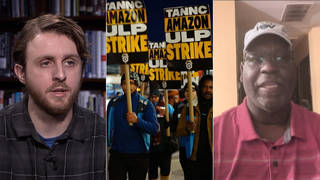

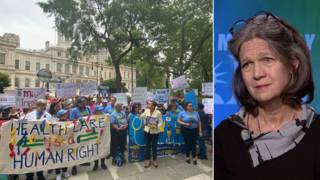
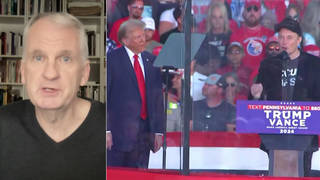



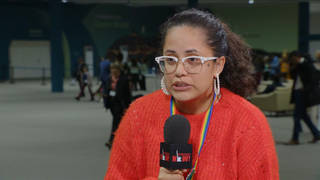

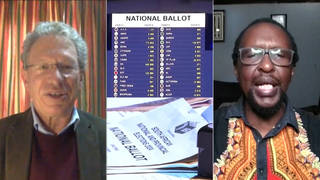
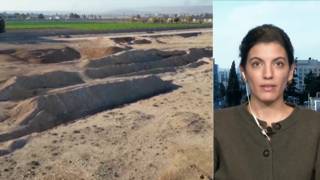
Media Options